Introduction
In the rapidly evolving landscape of artificial intelligence, organizations are discovering the transformative potential of AI Proof of Concepts (PoCs). These initial demonstrations serve as critical stepping stones, allowing businesses to validate the feasibility of AI solutions before committing to full-scale implementation. By embracing a structured approach to PoCs, companies can mitigate common challenges, enhance operational efficiency, and align AI initiatives with their strategic goals.
This article delves into the essential steps for launching an effective AI PoC, identifying key success metrics, overcoming resistance to change, and preparing for a seamless transition to full-scale implementation. With practical insights and actionable strategies, organizations can confidently navigate the complexities of AI adoption and unlock new avenues for growth and innovation.
Understanding the Importance of AI Proof of Concept
A Proof of Concept (PoC) in artificial intelligence acts as a crucial initial demonstration to validate the feasibility of an AI approach before committing to full-scale implementation. It enables organizations to test hypotheses, evaluate relevant technologies such as Small Language Models (SLMs), and assess the potential impacts on business processes.
By conducting a PoC, you can identify common challenges, such as:
- Poor master data quality
- Integration concerns
Early on, refine your approach, and address stakeholder hesitations regarding complexity and cost. Many organizations perceive AI projects as time-intensive and costly, which can lead to ‘AI Implementation Paralysis’—a hesitation to start due to fears of complexity and resource allocation.
This proactive step is essential to ensure that the proposed AI approach aligns with your organization’s specific goals and effectively addresses the actual needs of the business, ultimately leading to informed decision-making and strategic resource allocation.
Moreover, as illustrated in our case study on enhancing operational efficiency through GUI automation, such initiatives can significantly improve workflow and decision-making processes.
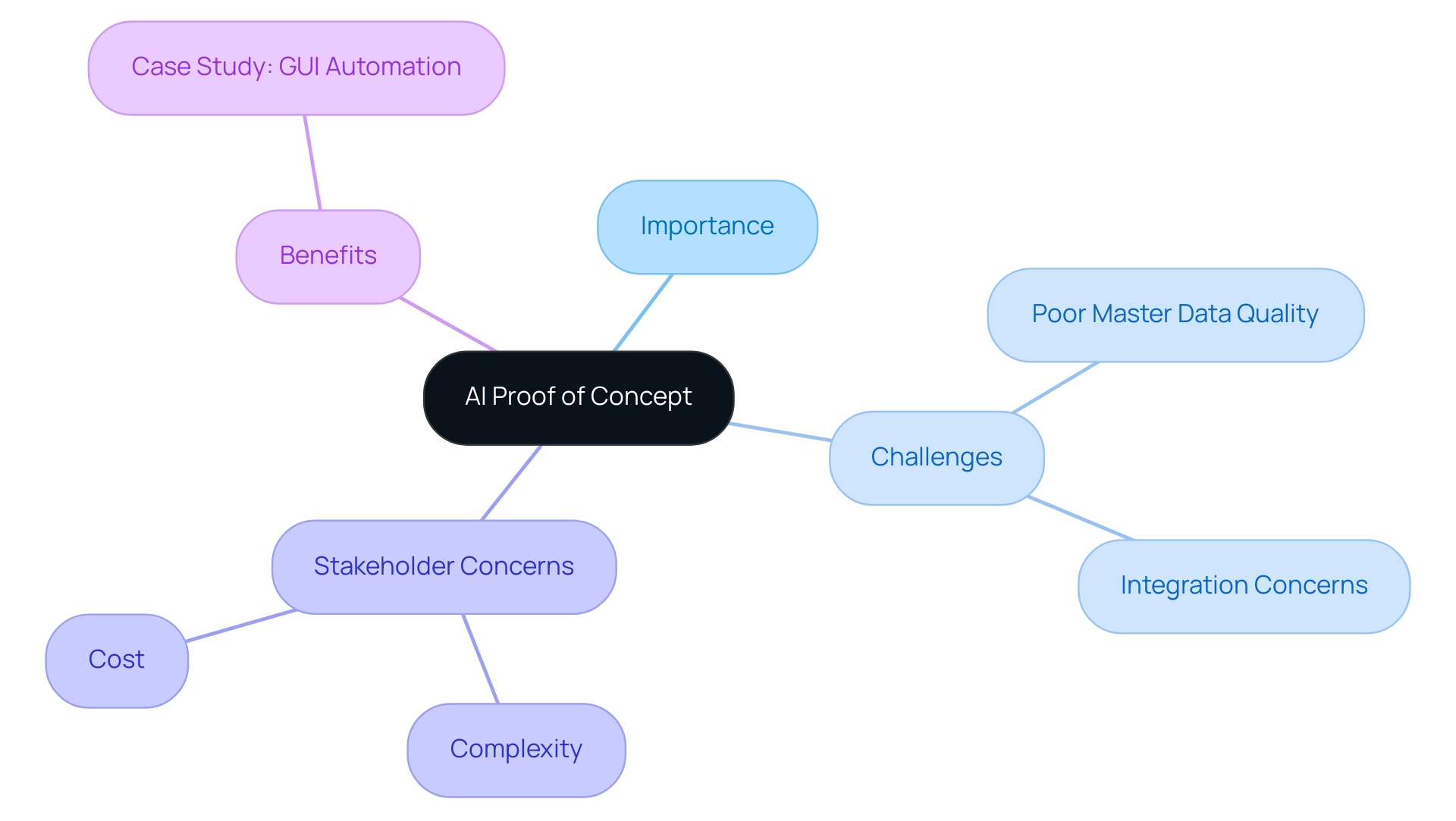
Step-by-Step Guide to Launching Your AI Proof of Concept
-
Define Your Objectives: Begin by clearly outlining the goals of your AI PoC. Identify the specific problem you aim to solve, such as overcoming repetitive tasks or addressing staffing shortages, and how AI, in conjunction with RPA solutions, can contribute to resolving it. This will guide your project and keep it focused.
-
Assemble Your Team: Gather a cross-functional team that includes stakeholders from IT, operations, and relevant business units. Their diverse perspectives will enrich the PoC process and ensure alignment with organizational needs, especially in identifying opportunities for RPA implementation.
-
Select the Right Technology: Research and choose AI technologies and RPA options that best fit your objectives. Consider factors such as scalability, integration capabilities, and vendor support. Ensure the technologies align with your goal of enhancing operational efficiency and modernizing outdated systems.
-
Develop a Prototype: Create a prototype that showcases the core functionality of your AI system, integrating RPA where applicable. This should be a simplified version that allows you to test your hypotheses without extensive resource investment.
-
Conduct Testing: Implement your prototype in a controlled environment. Collect feedback from users and evaluate the performance of the AI system alongside RPA functionalities against your defined objectives. This phase is crucial for identifying any areas for improvement and ensuring that the approach reduces errors and boosts productivity.
-
Analyze Results: Evaluate the outcomes of the testing phase. Did the AI approach, in conjunction with RPA, meet the predefined objectives? What insights were gained? This analysis will inform your next steps and decisions on scaling, especially in terms of leveraging Business Intelligence to extract actionable insights.
-
Prepare for Scaling: Based on the results, develop a plan for expanding the AI application and RPA across the organization. Consider necessary adjustments, resource allocation, and stakeholder engagement strategies to facilitate a smooth transition.
-
Communicate Findings: Share the results of your PoC with key stakeholders. Highlight successes, challenges, and recommendations for moving forward. Highlight how RPA tools can tackle workplace challenges, renew outdated systems, and improve efficiency, which is essential for gaining support for full-scale implementation.
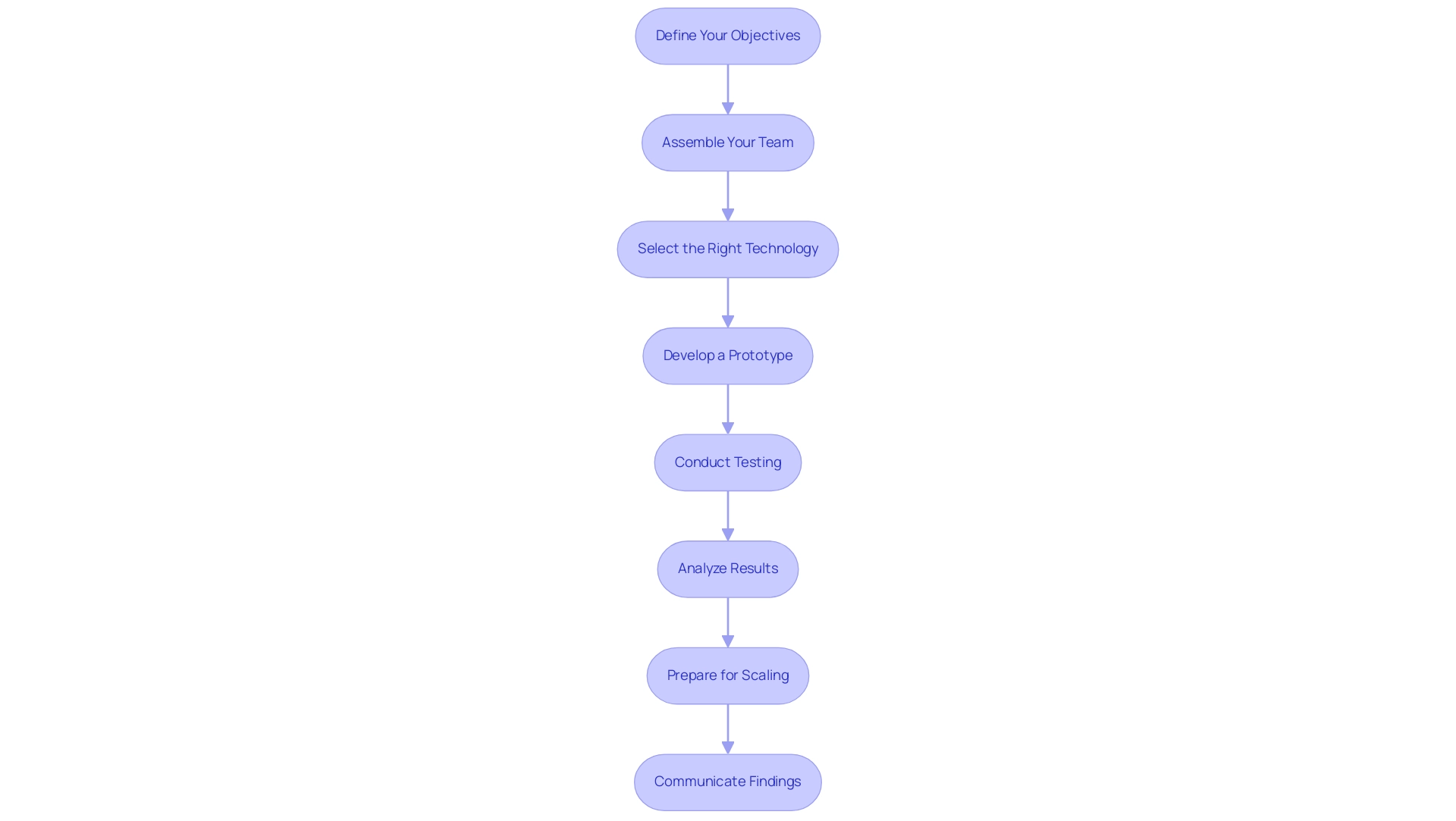
Identifying Key Metrics for Success
To effectively evaluate the success of your AI Proof of Concept (PoC) and its integration with Robotic Process Automation (RPA), it is imperative to define key metrics that will provide insight into its performance. Consider the following metrics:
-
Accuracy: Measure how accurately the AI model performs in comparison to benchmarks or expected outcomes. This is critical in assessing the model’s reliability, especially when utilizing innovative tools like EMMA RPA, which enhances accuracy through intelligent automation.
-
Time Savings: Calculate the reduction in time taken to complete tasks with the AI approach versus manual processes. This metric highlights efficiency gains, particularly through RPA’s ability to automate repetitive tasks and improve workflows, thus alleviating staffing shortages.
-
Cost Reduction: Analyze any decreases in operational costs as a result of implementing the AI system. This can include labor savings or decreased error rates, demonstrating the financial viability of utilizing tools like Power Automate, which streamlines workflows and lessens the burden on outdated systems.
-
User Adoption Rate: Monitor how quickly and effectively users embrace the new AI system. High adoption rates suggest that the approach meets user needs and is user-friendly, facilitating a smoother transition to automated processes.
-
Return on Investment (ROI): Assess the financial return produced by the AI system in relation to its implementation costs. This metric is essential for justifying the investment to stakeholders, particularly when the ROI risk is borne by providers who recognize the value of delivering successful automation offerings.
By identifying and tracking these key metrics, organizations can gain valuable insights into the effectiveness of their AI PoC and make informed decisions about future implementations, ultimately driving business productivity and enhancing decision-making through RPA and tailored AI offerings like EMMA RPA and Power Automate, which promote collaboration between human workers and automated systems.
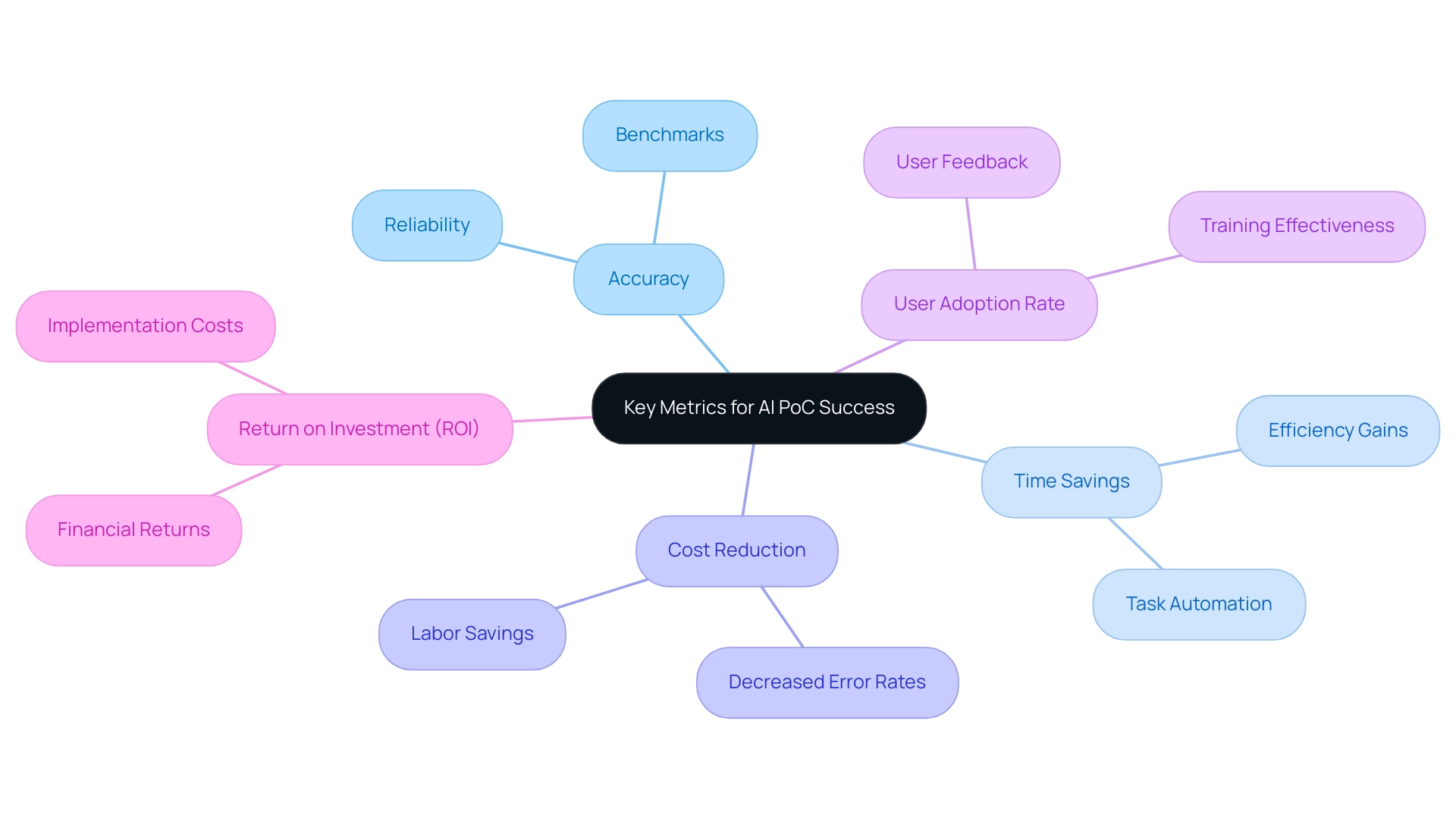
Overcoming Resistance to Change
-
Communicate Clearly: Openly discuss the purpose and benefits of the AI Proof of Concept (PoC) with all employees. Address any concerns and emphasize how the approach will enhance their work rather than replace them, especially as our tailored AI offerings are designed to align with specific business goals.
-
Involve Employees in the Process: Encourage participation from employees in the development and testing phases of the PoC. Their involvement fosters a sense of ownership and can lead to valuable feedback, ensuring that our GenAI workshops and training sessions effectively equip them with practical skills.
-
Provide Training and Support: Offer training sessions to help employees become familiar with the new technology, particularly focusing on how to utilize Robotic Process Automation (RPA) to streamline their workflows. Providing support during the transition can alleviate fears and build confidence in using these AI solutions.
-
Highlight Success Stories: Share success stories and positive outcomes from the PoC to demonstrate its value. This can motivate employees and create a positive narrative around the change, showcasing how Business Intelligence can transform raw data into actionable insights that drive growth.
-
Emphasize Business Intelligence: Highlight the critical role of Business Intelligence in enabling informed decision-making by turning raw data into actionable insights. This can empower employees and enhance their understanding of how these tools can benefit their roles.
-
Expand on GenAI Workshops: Detail how our GenAI workshops provide hands-on training, equipping employees with the necessary skills to implement AI applications effectively. This training focuses on real-world applications, ensuring that employees are prepared to leverage AI technologies in their daily tasks.
-
Be Patient and Flexible: Understand that change takes time. Be open to feedback and willing to make adjustments to the implementation plan based on employee input. By introducing Hayley, your AI-based junior consultant, you can provide personalized consulting guidance to help navigate these changes effectively.
By proactively addressing resistance to change and leveraging our resources, organizations can create a more supportive environment for the successful adoption of AI technologies.
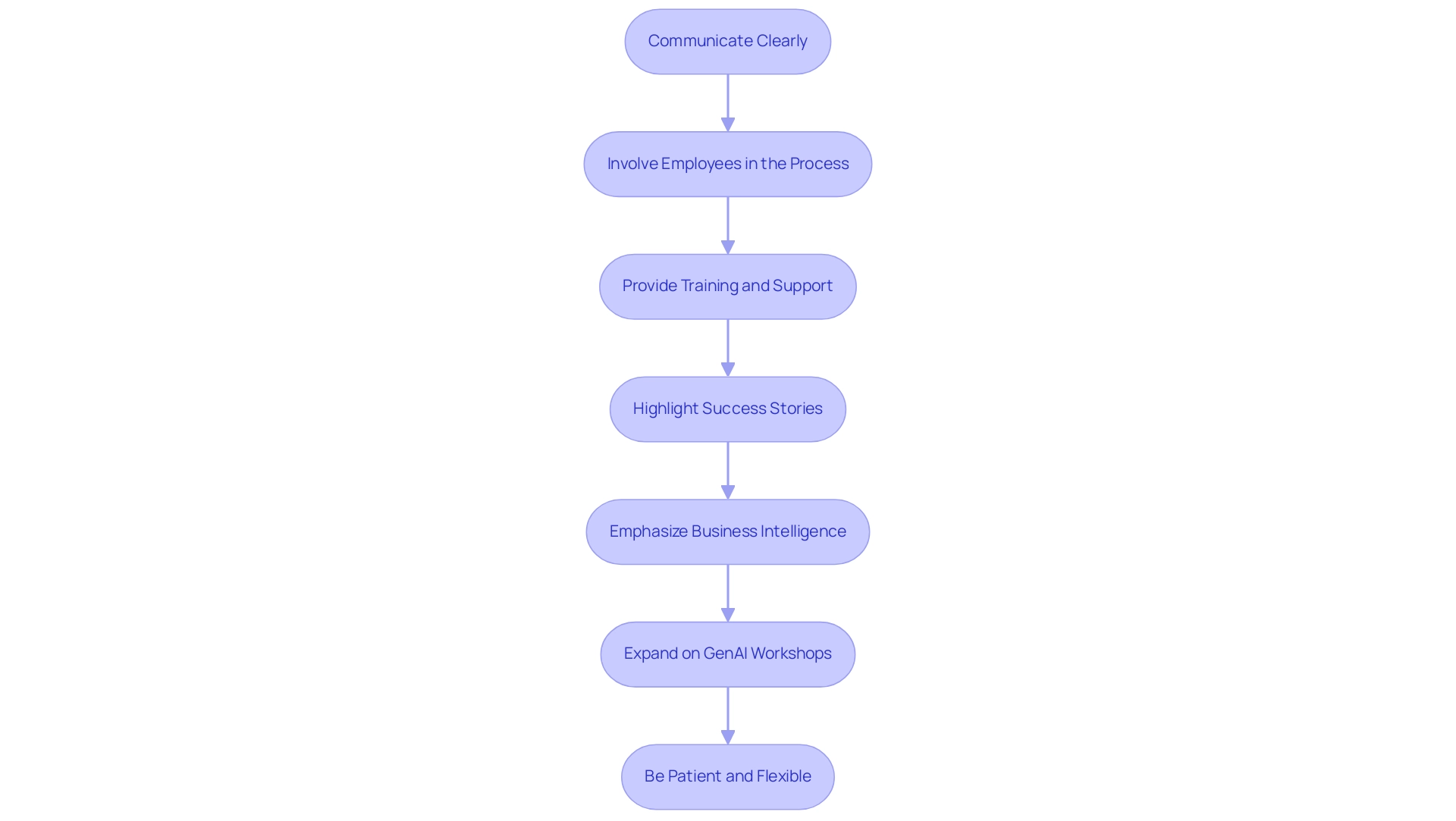
Preparing for Full-Scale Implementation
-
Review PoC Outcomes: Analyze the results of the Proof of Concept (PoC) thoroughly. Determine strengths, weaknesses, and areas for enhancement to ensure the approach aligns with your business objectives and tackles any challenges encountered during implementation.
-
Develop an Implementation Plan: Create a comprehensive plan outlining the steps to roll out the AI system across your organization. This plan should include timelines, required resources, and key responsibilities, ensuring that the integration of RPA enhances operational efficiency.
-
Engage Stakeholders: Maintain continuous communication with stakeholders throughout the implementation process. Their ongoing support will be crucial for leveraging the benefits of RPA and overcoming any challenges that arise, ensuring that the AI approach is tailored to meet your specific business needs.
-
Monitor and Adjust: Once the AI system is implemented, closely monitor its performance. Be ready to make modifications based on practical usage and input from users, ensuring that the approach stays effective in generating data-driven insights and efficiency in operations. Business Intelligence plays a key role here, as it can help transform raw data into actionable insights, facilitating informed decision-making.
-
Foster a Culture of Continuous Improvement: Encourage a mindset of continuous improvement by regularly evaluating the AI system’s performance and exploring opportunities for enhancements. Highlight how RPA can alleviate the burden of manual, repetitive tasks, thus contributing to this culture of improvement. This approach will help your organization adapt to the rapidly evolving AI landscape and maintain a competitive edge.
By following these steps, organizations can effectively transition from a PoC to a full-scale implementation of AI solutions, driving innovation and operational efficiency while overcoming technology implementation challenges.
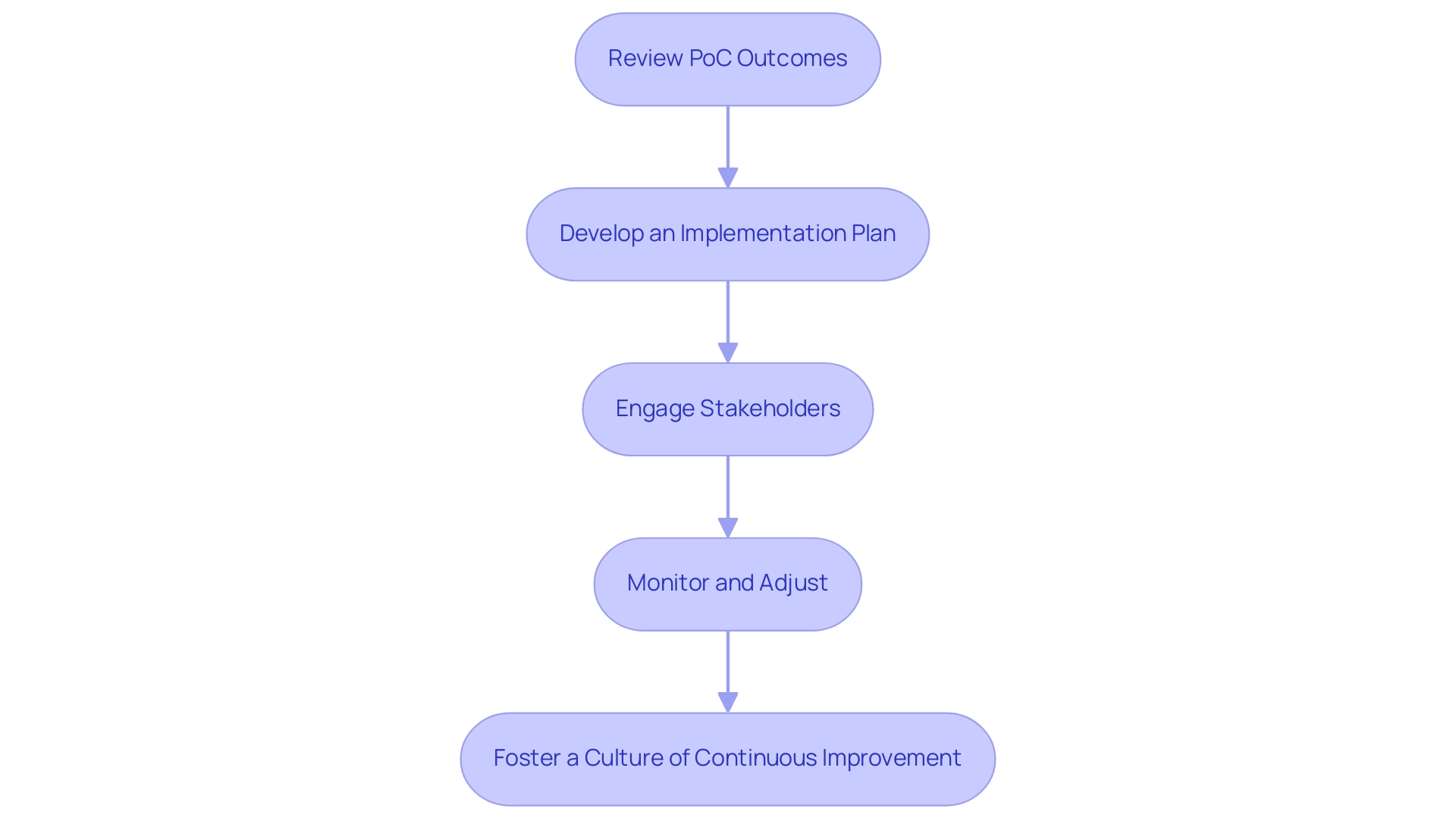
Conclusion
Embracing AI Proof of Concepts (PoCs) is a strategic move that enables organizations to validate solutions before committing to extensive implementations. By following a structured approach—defining clear objectives, assembling the right team, selecting appropriate technologies, and testing prototypes—businesses can confidently navigate the complexities of AI adoption. Each step is crucial for addressing common challenges and ensuring that the AI initiatives are aligned with organizational goals.
Key metrics such as accuracy, time savings, cost reduction, user adoption rate, and return on investment serve as essential benchmarks for evaluating the success of AI integrations. By closely monitoring these indicators, organizations can make informed decisions that drive productivity and enhance operational efficiency. Moreover, overcoming resistance to change through effective communication, training, and highlighting success stories fosters a culture of acceptance and readiness for innovation.
The transition from a PoC to full-scale implementation is not just a technical shift; it is a transformative journey that requires careful planning and stakeholder engagement. By reviewing outcomes, developing comprehensive implementation plans, and fostering continuous improvement, organizations can create a robust framework for leveraging AI technologies. This proactive approach not only mitigates risks but also positions businesses to harness the full potential of AI, ultimately unlocking new avenues for growth and innovation.
The time to act is now; embracing AI through PoCs can lead to significant advancements in operational efficiency and strategic success.

